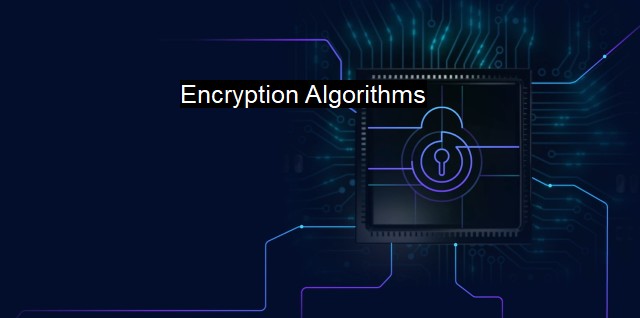What are Encryption Algorithms?
The Power of Encryption Algorithms in Cybersecurity: Ensuring Confidentiality and Data Protection.
Encryption algorithms are crucial software tools used in cybersecurity and antivirus solutions to secure data by converting informational content into an unrecognizable format. The unrecognizable format is a ciphertext created from standardized algorithms formulated based on chosen plain-text data. The transformation from plain-text to ciphertext is controlled by an encryption key, a specialized sequence varying in complexity and providing the first defense barrier against unauthorized individuals.Primarily, the purpose of encryption algorithms is twofold: authenticate and maintain the privacy of data communication, and keep the data stored in certain databases private. Encryption algorithms, as part of data protection strategies, ensure confidentiality, integrity, and availability, also known as CIA triad in cybersecurity. These algorithms prevent unauthorized access by making data unreadable to unauthorized individuals, ensuring that only authorized recipients with the correct decryption key can revert data back to its original format.
There are two major types of encryption algorithms: Symmetric and Asymmetric. Symmetric encryption, also known as private-key encryption, uses the same key for both encryption and decryption procedures. Advanced Encryption Standard (AES) and Data Encryption Standard (DES) are a few examples of symmetric encryption. These are relatively fast and simple, but sharing the key with the recipient securely is their greatest challenge.
On the other hand, asymmetric encryption, known as public-key encryption, has separate encryption and decryption keys. The public key encrypts data, whereas a private key decrypts it. Therefore, even if an attacker obtains the public key, the data remains secure as the private key-kept secret-is necessary for decryption. The Rivest-Shamir-Adleman (RSA) encryption algorithm exemplifies asymmetric encryption. It offers robust security; it’s slower than symmetric encryption due to the dual-key complexity.
In the context of antivirus software, encryption algorithms add a security layer by preventing unauthorized access and maintaining the privacy and integrity of data. Antivirus programs often use these algorithms to encrypt the definition updates sent to users' devices. If these updates are intercepted without encryption, hackers can manipulate them to bypass the antivirus system or even to damage users' computer systems.
Many contemporary antivirus solutions also deploy encryption algorithms for scanning or monitoring encrypted traffic over Secure Sockets Layer (SSL) and Transport Layer Security (TLS) protocol channels. These prevent cybercriminals from exploiting these data tunnels to sneak malignant payloads into networks.
Because encryption algorithms are not unconditionally invulnerable, best practices in cybersecurity and antivirus demand the usage of the most recent, secure, and sophisticated encryption algorithm, adjusted to accommodating innovative technological developments and the evolving threat landscape.
Encryption algorithms stand as the strong fortifying walls and the surveillance agents in the digital world, securing data confidentiality, ensuring communication integrity, and providing system availability. They not only scramble valuable data to make it unreadable to prying eyes but also verify data accuracy by detecting changed information and identifying the cause as a legitimate update or a cyber attack. Therefore, a profound understanding of encryption algorithms is fundamental to users, cybersecurity professionals, and indeed anyone who regards the importance of data privacy and security today.

Encryption Algorithms FAQs
What is an encryption algorithm and how does it work?
An encryption algorithm is a process used to convert plaintext (i.e., readable data) into ciphertext (i.e., unreadable data) to protect the confidentiality of data during transmission. It typically involves using a key to scramble the original message and then using the same key to unscramble the message at the receiving end. The strength and complexity of the encryption algorithm determine the level of security it provides.What are some examples of encryption algorithms used in cybersecurity?
Some common encryption algorithms used in cybersecurity include Advanced Encryption Standard (AES), RSA, Blowfish, and Twofish. AES, in particular, is widely considered to be one of the most secure encryption algorithms currently available. Other popular algorithms include Triple DES, IDEA, and RC4.How can encryption algorithms help protect against viruses and other malware?
Encryption algorithms can help protect against viruses and other malware by making it more difficult for attackers to access and steal sensitive data. By encrypting data using a strong algorithm, even if an attacker gains access to the encrypted data, it will be illegible without the correct key to decrypt it. This can help prevent sensitive information such as login credentials or financial details from falling into the wrong hands.What should I look for in a good encryption algorithm for my organization's cybersecurity needs?
When selecting an encryption algorithm for your organization's cybersecurity needs, it is important to consider a few key factors. First, the algorithm should be strong enough to provide adequate security for your organization's sensitive data. Additionally, the algorithm should be widely used and well-vetted by the cybersecurity community to ensure that it has been thoroughly tested and can be considered reliable. Finally, the algorithm should be compatible with your organization's existing systems and technologies to ensure a smooth implementation process.| | A | | | B | | | C | | | D | | | E | | | F | | | G | | | H | | | I | | | J | | | K | | | L | | | M | |
| | N | | | O | | | P | | | Q | | | R | | | S | | | T | | | U | | | V | | | W | | | X | | | Y | | | Z | |
| | 1 | | | 2 | | | 3 | | | 4 | | | 7 | | | 8 | | |||||||